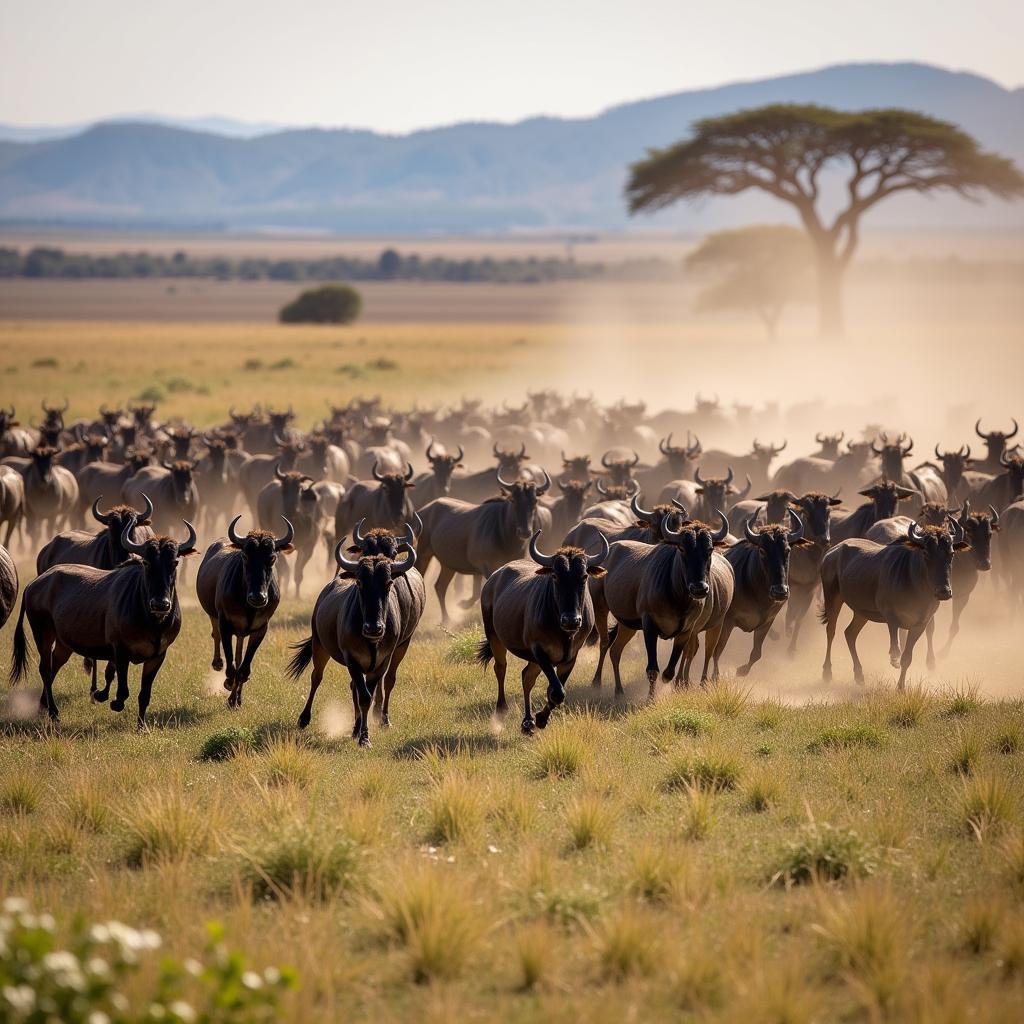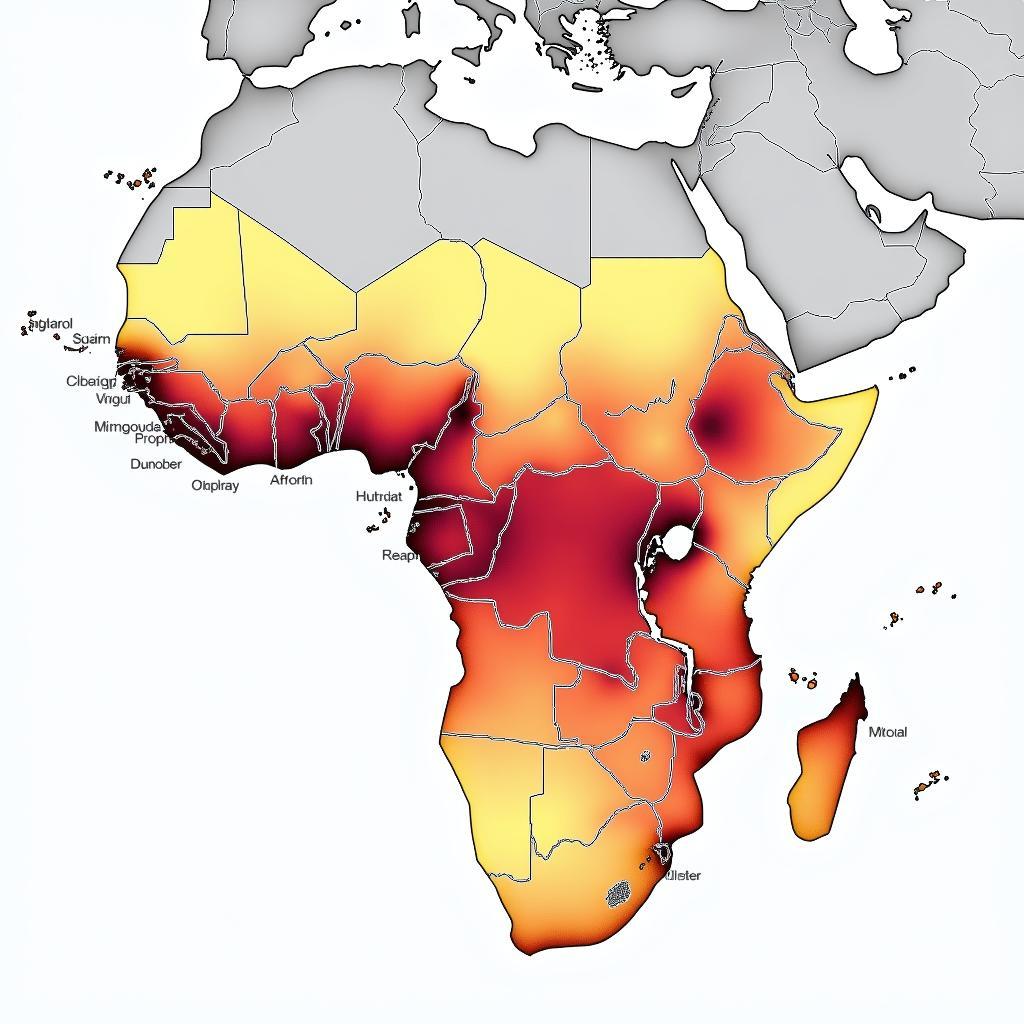African Jungle Animals in Herds: A Symphony of Survival
The African jungle, a tapestry woven with vibrant life, echoes with the symphony of its inhabitants. Among them, the animals that roam in herds stand out, their collective strength a testament to their survival in this challenging yet enchanting ecosystem. From the iconic African zebra with its striking stripes to the mighty African forest elephant, these herds paint a captivating picture of adaptation, resilience, and the delicate balance of nature.
The Power of the Collective: Why Herds Thrive in the Jungle
Life in the African jungle presents a myriad of challenges, from predators lurking in the shadows to the constant competition for food and resources. For many animals, facing these challenges alone can be a daunting task. This is where the herd dynamic comes into play, offering a powerful strategy for survival.
Safety in Numbers: A United Front Against Predators
One of the most significant advantages of living in a herd is the safety it provides against predators. With multiple eyes, ears, and noses on high alert, the chances of detecting a predator increase exponentially. This collective vigilance allows for quicker reactions, giving the herd a crucial head start to escape.
 African Jungle Animals Herds: Predator Defense
African Jungle Animals Herds: Predator Defense
Furthermore, the sheer size of the herd can be intimidating to predators, making them think twice before attacking. A lone predator would think twice before taking on a united front of hooves, horns, and sheer determination.
Food Foraging: Strength in Numbers
Finding adequate food and water sources in the vast expanse of the African jungle can be a challenge. However, herds have a unique advantage in this aspect as well. By moving together, they can cover more ground, increasing their chances of encountering patches of fresh grass, watering holes, or fruit-bearing trees.
Raising the Next Generation: Collective Care for the Young
The survival of any species hinges on its ability to successfully raise its young. In herds, the responsibility of protecting and nurturing the next generation is shared. The collective strength of the herd offers a safe haven for vulnerable young, shielding them from predators and ensuring their survival.
Navigating the Jungle: The Wisdom of the Herd
Navigating the dense and often unforgiving terrain of the African jungle can be treacherous. Herds rely on the collective experience and wisdom of their members, particularly the older, more experienced individuals, to guide them through challenging landscapes, seasonal migrations, and potential dangers.
A Closer Look at Iconic African Jungle Herds
The African jungle is home to a diverse array of animals that have adopted the herd lifestyle. Let’s delve into the lives of some of these remarkable creatures:
African Forest Elephants: Guardians of the Jungle
The African forest elephant, smaller than its savanna counterpart, is a true denizen of the jungle. These gentle giants roam the forests in tightly-knit family groups led by a matriarch, the oldest and most experienced female. Their immense size and strength make them formidable forces in the jungle, shaping their environment and influencing the lives of other species.
Their diet plays a crucial role in seed dispersal, contributing to the biodiversity of the jungle. Despite their size, they are remarkably elusive, their movements through the dense vegetation often silent and deliberate.
To learn more about the adaptations that allow these magnificent creatures to thrive in the jungle, explore our article on African forest elephant adaptations.
African Jungle Wildebeest: Masters of Migration
The thundering hooves of the African jungle wildebeest echo across the plains, their massive migrations a testament to their resilience and adaptability. These large antelopes, driven by the search for greener pastures and suitable breeding grounds, embark on perilous journeys, facing off against predators and navigating treacherous landscapes.
Their movements, a spectacle of nature, are a testament to the power of instinct and the unwavering drive for survival that binds these animals together.
Zebras: A Tapestry of Stripes and Social Bonds
The African zebra, with its iconic black and white stripes, is a symbol of the African savanna. But did you know that these stripes are not just for show? They serve a crucial purpose, disrupting the vision of predators, making it difficult for them to single out individuals within the herd.
Zebras live in herds led by a dominant stallion, who protects and guides his group. These herds exhibit complex social structures and communication methods, using a combination of vocalizations, body language, and facial expressions to interact with each other.
The Fragile Balance: Threats to Herds in the African Jungle
While the herd dynamic offers numerous advantages, life in the African jungle is fraught with challenges.
Habitat Loss and Fragmentation: Shrinking Safe Havens
One of the most significant threats facing African jungle animals, particularly those that live in herds, is habitat loss and fragmentation. As human populations expand and encroach upon their natural habitats, these animals are increasingly confined to smaller, more isolated areas. This fragmentation disrupts migration routes, limits access to essential resources, and increases competition, making it more challenging for herds to thrive.
Poaching and Human-Wildlife Conflict: A Growing Threat
Poaching for bushmeat, ivory, and other animal products continues to pose a severe threat to many African jungle animals, including those that live in herds. This illegal activity, driven by demand and fueled by poverty and weak law enforcement, decimates populations and disrupts the delicate balance of the ecosystem.
Furthermore, as human settlements expand closer to wildlife areas, conflicts between humans and animals become more frequent.
These encounters can be dangerous for both parties involved and often result in the displacement or death of animals.
Climate Change: An Uncertain Future
The impacts of climate change, including prolonged droughts, erratic rainfall patterns, and extreme weather events, are already being felt across the African continent. These changes disrupt traditional migration patterns, affect the availability of food and water sources, and increase the spread of diseases, putting additional pressure on animal populations, including those that rely on the herd dynamic for survival.
Conservation Efforts: Protecting the Majesty of African Jungle Herds
Recognizing the importance of preserving these magnificent creatures and their delicate ecosystems, numerous conservation efforts are underway across Africa.
Protecting Habitats: Creating Safe Spaces
Establishing and maintaining protected areas, national parks, and wildlife corridors is crucial to safeguarding the remaining habitats of African jungle animals. These designated areas provide safe havens for wildlife, allowing them to roam freely and thrive without the threat of habitat loss or human encroachment.
Combating Poaching: Strengthening Law Enforcement and Reducing Demand
Tackling the persistent threat of poaching requires a multi-pronged approach. Strengthening law enforcement, increasing penalties for poachers, and improving intelligence networks are essential to deterring this illegal activity.
Community-Based Conservation: Empowering Local Communities
Empowering local communities to become stewards of their natural heritage is crucial for long-term conservation success. By involving local people in conservation efforts, providing them with alternative livelihoods, and raising awareness about the importance of wildlife protection, we can foster a sense of ownership and responsibility, creating a sustainable future for both people and wildlife.
Addressing Climate Change: Global Action for a Sustainable Future
Mitigating the impacts of climate change requires a global effort. Reducing greenhouse gas emissions, transitioning to renewable energy sources, and promoting sustainable land management practices are essential steps in protecting the delicate balance of the African jungle and the incredible animals that call it home.
Conclusion
The sight of African animals moving in herds across the vast expanse of the African jungle is a testament to the power of adaptation, resilience, and the delicate balance of nature. These herds, each with their unique characteristics and survival strategies, contribute to the rich tapestry of life that makes the African jungle such a captivating and vital ecosystem.
It is our shared responsibility to protect these magnificent creatures and their fragile habitats, ensuring that the symphony of their survival continues to echo through the jungles for generations to come. To learn more about the fascinating world of African wildlife, visit our website for more in-depth articles and information.
Need Help?
For further support, feel free to reach out to our 24/7 customer service team.
Phone Number: +255768904061
Email: kaka.mag@gmail.com
Address: Mbarali DC Mawindi, Kangaga, Tanzania.

